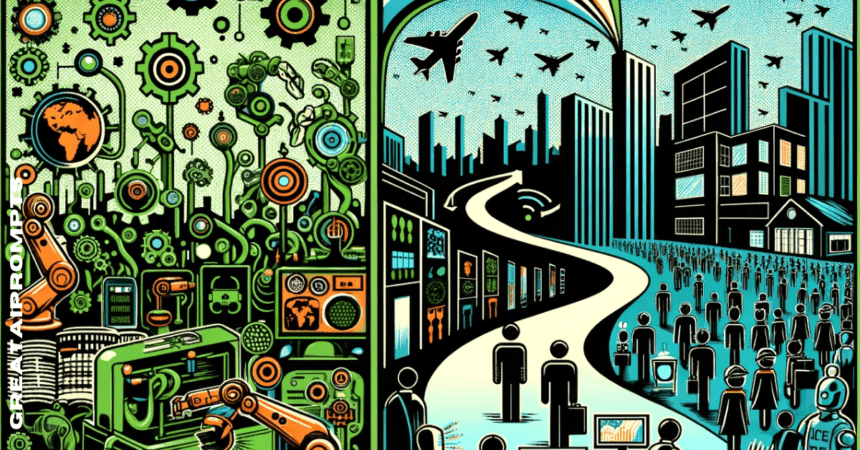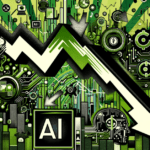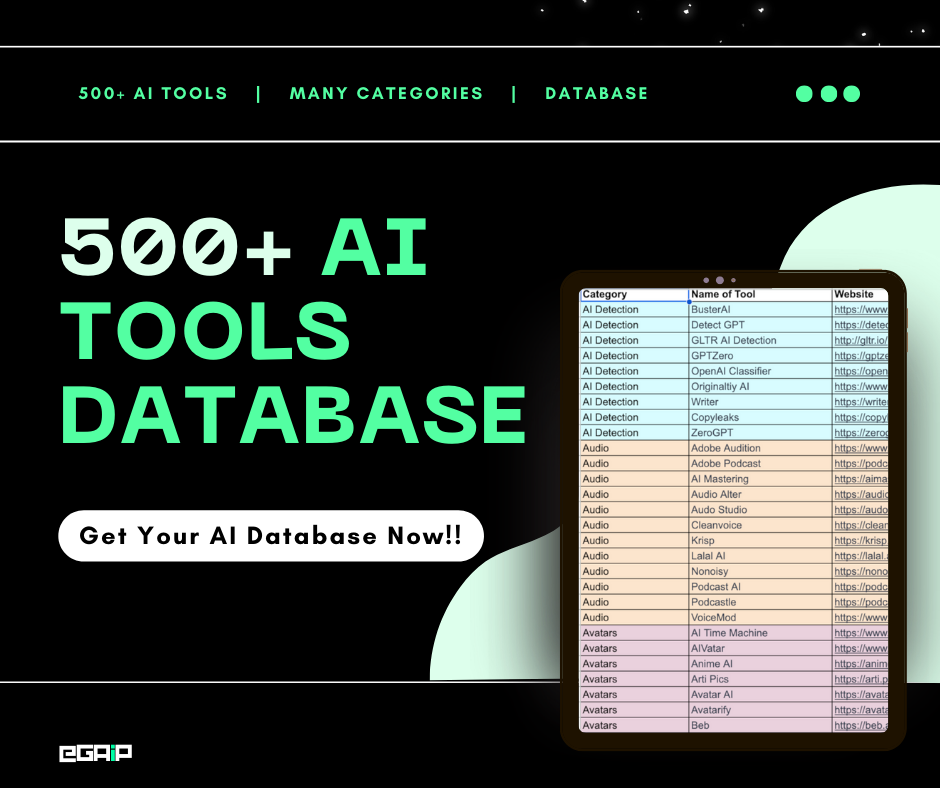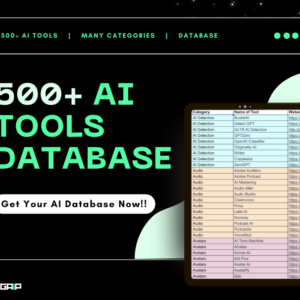Artificial intelligence (AI) is quickly changing the job market, which means challenges and chances exist.
The World Economic Forum’s 2023 “Future of Jobs” poll found that over 60% of companies know that AI and other cutting-edge technologies are becoming more popular, which will have a big effect on the job market.
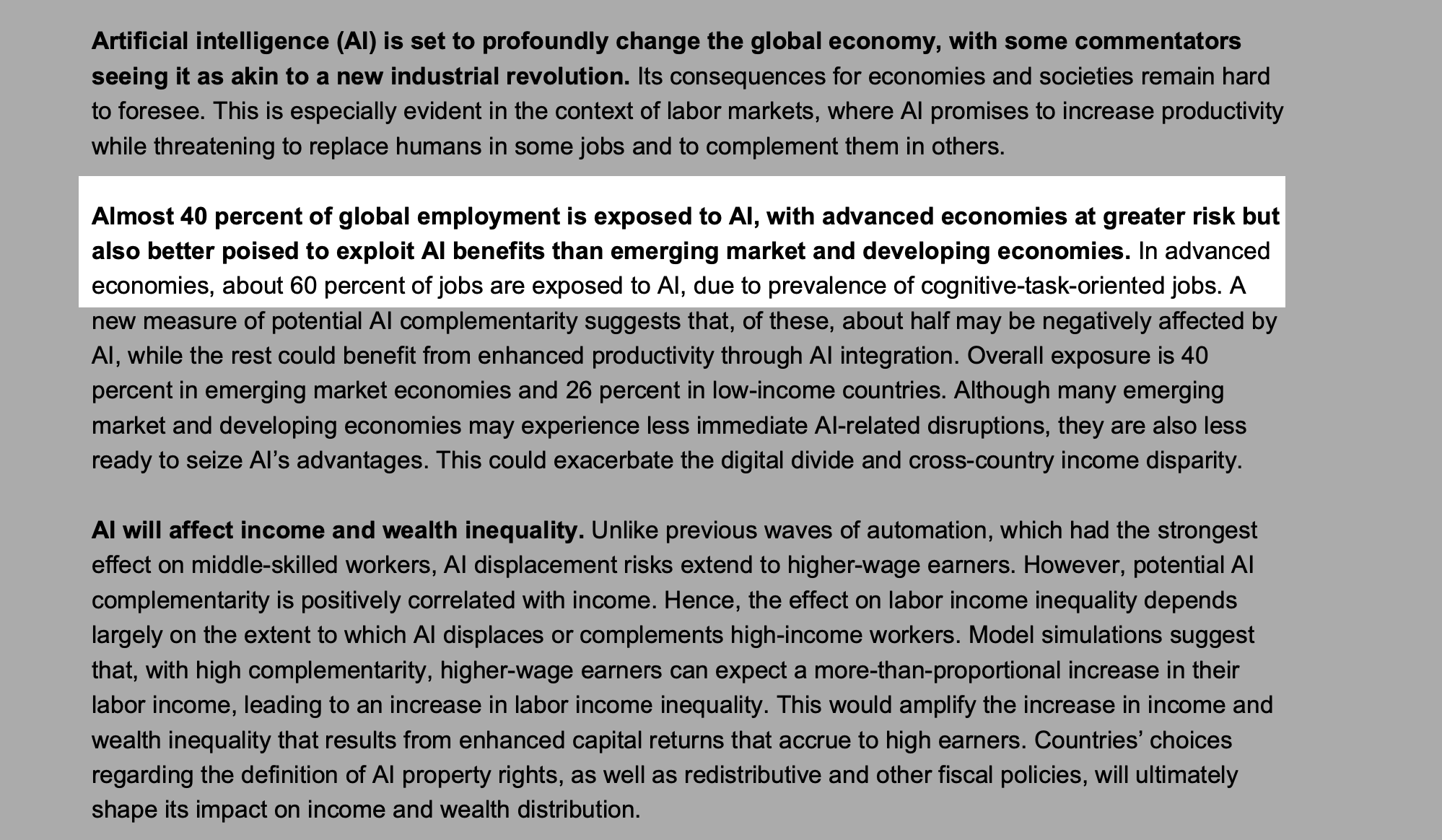
AI-driven job disruption particularly affects educated, white-collar workers, with half of the businesses having already integrated AI into their operations.
According to the IMF’s research, almost 40% of jobs worldwide are affected by AI, and AI could either supplement or replace different types of jobs.
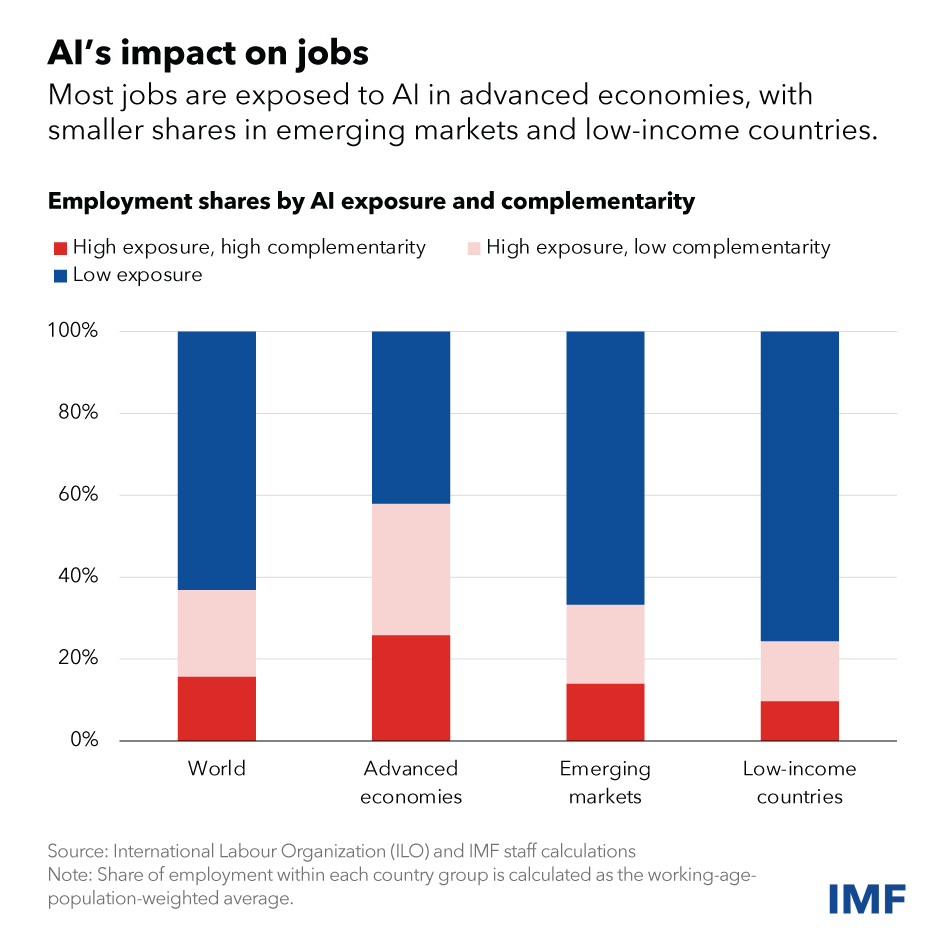
There are, however, worries about job loss, and data from different fields shows what percentage of jobs are at high risk of being automated.
So, in this post, we’ll check out the current statistical data around AI jobs that will help you analyze AI’s impact and the current state of the job market worldwide.
Let’s begin!
AI Jobs Statistics at Glance (Top Data)
Here is a list of all the important statistics:
- Global AI Funding: In 2022, AI investments reached a remarkable $45 billion, highlighting the market’s growing confidence in AI technology and its potential across various industries. (Hostinger)
- Top Countries for AI Investment: The United States and China lead in AI investments, making them prime locations for AI development and job opportunities.
- AI Startup Funding Growth: Funding for AI startups saw an average increase of 66% between 2021 and 2023, indicating a robust and expanding ecosystem for AI innovation. (Exploding Topics)
- AI Skills Demand vs. Supply: There’s a significant gap between the high demand for AI skills and the current talent pool, underscoring the need for education and training in AI technologies.
- Average Salary for AI Professionals: The high average salary of $160,000 for AI professionals reflects the industry’s willingness to invest in skilled workers. (AmbitionBox)
- AI’s Potential for Job Automation: By 2030, AI could automate 30% of work hours in the US economy, shifting the focus towards more strategic and creative tasks. (McKinsey & Company)
- Generative AI’s Impact on Business: Over 95% of executives agree that generative AI will revolutionize AI applications, extending its use to new domains like product design and customer engagement. (HCLTech)
- AI in Key Sectors: Banking, financial services, insurance, and healthcare are leading sectors in AI adoption, presenting numerous opportunities for AI-driven roles. (LeewayHertz)
- American Companies and AI Automation: The US’s dominance in industrial AI automation highlights the country’s innovative capabilities and the wide array of job prospects in AI-related fields. (Brookings)
- Future Projections for AI Industry: The AI industry is expected to be worth $190 billion by 2030, indicating its pervasive influence across all sectors.
- Job Growth Through AI Adoption: More than 50% of businesses surveyed plan to increase job positions due to AI adoption and digital transformation efforts.
- Investment in AI Training: 50% of companies plan to invest in training departments focused on AI adoption, emphasizing the importance of upskilling the workforce to meet future demands.
Average AI Job Salaries
The AI field is growing rapidly, and pay reflects the increasing demand for skilled workers. AI engineers, data scientists, machine learning, deep learning, and NLP professionals work in AI.
Due to their particular talents, these occupations might earn much more than the industry median.

The average AI engineer salary in the USA is $100,000 to $115,000, with a salary range spanning from $67,000 to $160,000.
The average base salary for AI engineers in the United States is reported to be around $133,347 per year, with the potential to increase based on experience and skills.
The average OpenAI salary ranges between $130,000 to $180,000 per year. (BusinessInsider)
Also, these tables can help you get a better idea of what the average AI job salaries are in the USA and India:
Average AI Job Salaries in the World (USD)
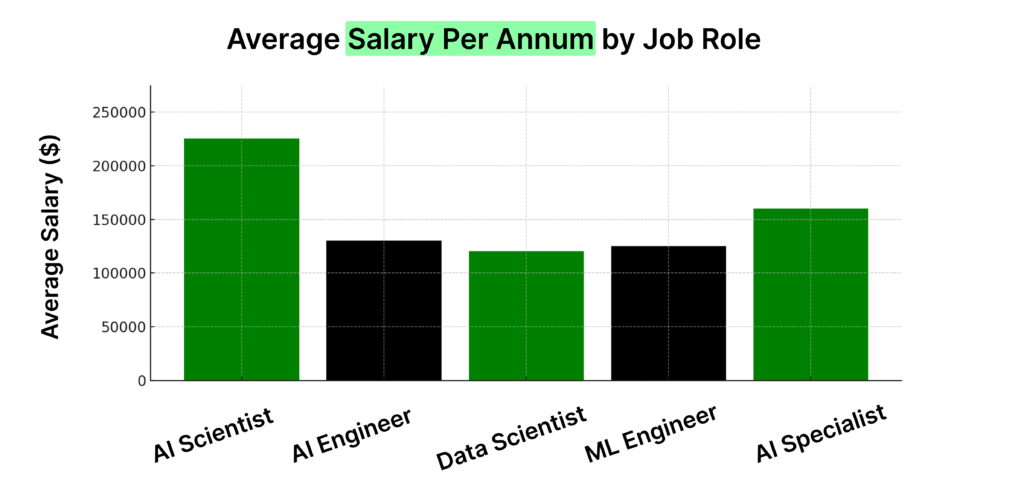
| Job Role | Average Salary (per annum) |
|---|---|
| AI Scientist | $150,000 – $300,000 |
| AI Engineer | $100,000 – $160,000 |
| Data Scientist | $90,000 – $150,000 |
| Machine Learning Engineer | $100,000 – $150,000 |
| AI Specialist | $120,000 – $200,000 |
Average AI Job Salaries in the USA (USD)
| Job Role | Average Salary (per annum) |
|---|---|
| AI Scientist | $120,000 – $250,000 |
| AI Engineer | $120,000 – $200,000 |
| Data Scientist | $100,000 – $180,000 |
| Machine Learning Engineer | $110,000 – $170,000 |
| AI Specialist | $130,000 – $220,000 |
Average AI Job Salaries in India (INR)
| Job Role | Average Salary (per annum) |
|---|---|
| AI Scientist | ₹30,00,000 – ₹60,00,000 |
| AI Engineer | ₹20,00,000 – ₹35,00,000 |
| Data Scientist | ₹15,00,000 – ₹25,00,000 |
| Machine Learning Engineer | ₹18,00,000 – ₹30,00,000 |
| AI Specialist | ₹25,00,000 – ₹40,00,000 |
Changes in Salaries
Over the past few years, the salaries of AI professionals have seen an upward trend, driven by the increasing adoption of AI technologies across various sectors.
Here is the table of the average change in AI job salaries over the last three years:
| Job Title | Average Salary 2024 (USD) | Change from Previous Year |
|---|---|---|
| AI Engineer | $136,620 – $174,713 | Increase |
| Machine Learning Engineer | $112,832 – $143,180 | Increase |
| Data Scientist | $117,944 – $140,000 | Increase |
| AI Programmer | $81,445 – $122,000 | Increase |
| AI Specialist | $128,976 – $141,355 | Increase |
The average AI job salaries have increased over the last few years, reflecting the growing demand for AI professionals and the competitive nature of the field.
Regional Variations in AI Wages
There are big differences in the usual wages for AI workers across the United States. Connecticut, California, South Carolina, Louisiana, and Minnesota are the states that pay the most for AI workers.
The average AI wage in Connecticut is over $176,000 a year, while the average AI wage in Tennessee is only $84,190 a year, making it the lowest state in the U.S.
There are clear differences between regions in places like Alaska and the District of Columbia, where AI has made the pay gap between tech and non-tech jobs 64% bigger.
California, on the other hand, is a tech hub, and its pay gap is stable. AI has the least impact on it, at just 5%.
Here is a table showing the regional variations in AI wages in the United States:
| State | Average AI Wage (per annum) |
|---|---|
| Connecticut | $176,000 |
| California | $160,000 |
| South Carolina | $150,000 |
| Louisiana | $140,000 |
| Minnesota | $135,000 |
| New York | $130,000 |
| Massachusetts | $125,000 |
| Texas | $120,000 |
| Illinois | $115,000 |
| Georgia | $110,000 |
| Tennessee | $84,190 |
The data shows that AI worker salaries vary greatly across the United States.
Connecticut, California, South Carolina, Louisiana, and Minnesota pay the most for AI professionals.
The best average AI wage in the U.S. is over $176,000 a year in Connecticut.
Tennessee’s lowest average AI wage in the U.S. is $84,190 a year.
AI Job Growth Statistics
The World Economic Forum says that AI will create about 97 million new jobs, which could ease worries about people losing their jobs.

According to a study by McKinsey, advances in AI could affect about 15% of the global workforce between 2016 and 2030, which could mean the loss of 400 million jobs.
AI market size is expected to reach $305.90 billion in 2024, with businesses increasingly replacing human tasks with AI solutions. Nearly 20 million manufacturing jobs could be lost to automation by 2030.
However, there’s also significant growth in generative AI jobs, with searches on Indeed for such positions increasing by almost 4,000% last year. (Source)
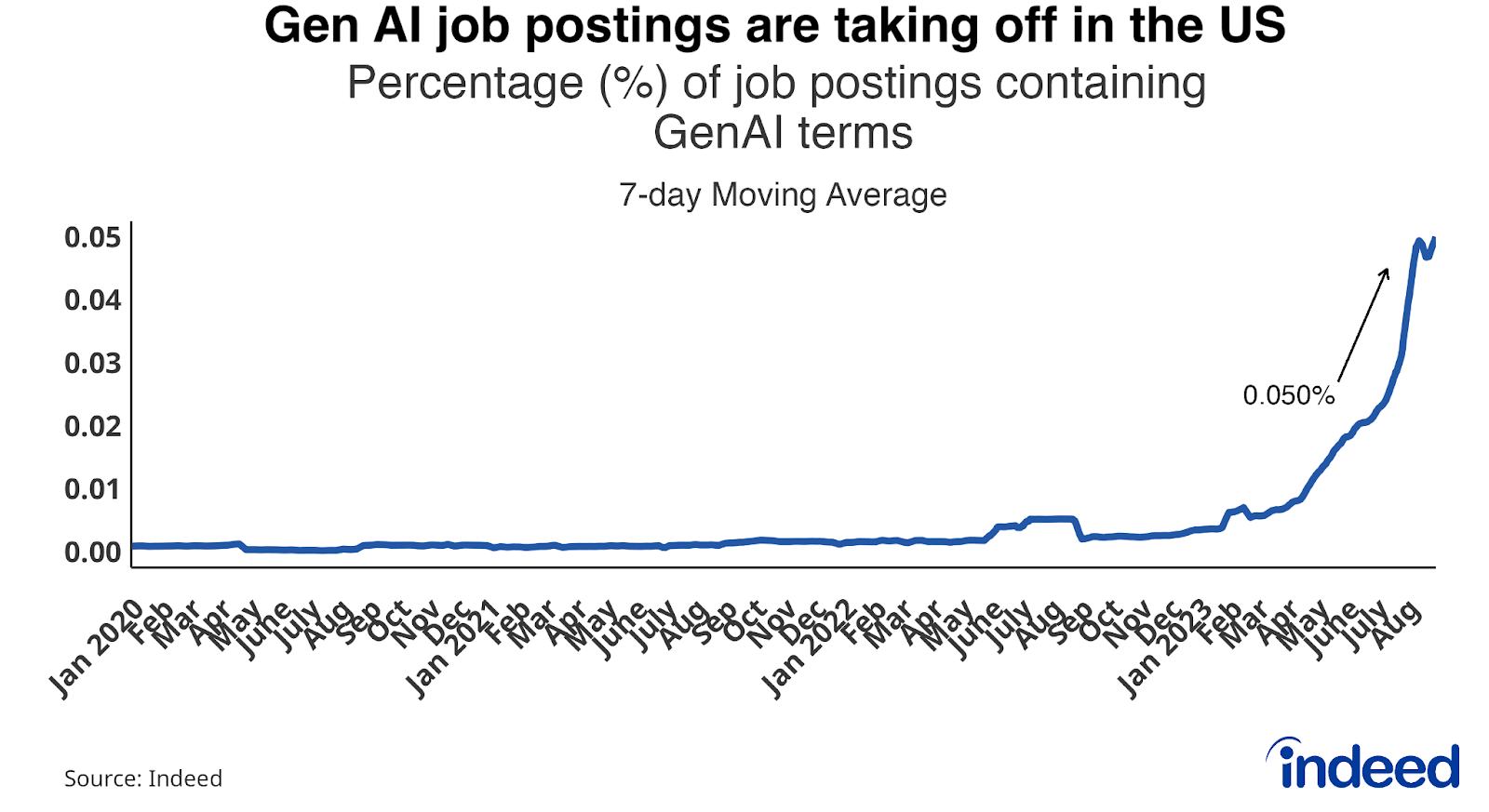
Furthermore, 83% of companies claim that AI is a top priority in their business plans, indicating the widespread integration and growth of AI technologies in various industries.
Here are some tables showing AI job growth statistics:
AI Market Size and Growth Rate (USD)
| Year | Market Size (in billions) | Growth Rate |
|---|---|---|
| 2022 | $452.6 | – |
| 2023 | $536.6 | 18.5% |
| 2024 | $634.2 | 18.2% |
| 2025 | $746.5 | 17.7% |
| 2026 | $874.5 | 17.1% |
| 2027 | $1,019.5 | 16.6% |
| 2028 | $1,183.5 | 16.1% |
| 2029 | $1,368.5 | 15.6% |
| 2030 | $1,576.5 | 15.2% |
AI Investment Required to Catch Up with the US (in billions)
| Country | 2030 | 2040 | 2050 |
|---|---|---|---|
| China | $1,200 | $2,400 | $3,600 |
| Japan | $400 | $800 | $1,200 |
| Germany | $200 | $400 | $600 |
| France | $200 | $400 | $600 |
| UK | $200 | $400 | $600 |
The AI market is expected to grow rapidly, with an annual growth rate of 15.2% between 2030 and 2025.
The US Bureau of Labor Statistics projects a 21% growth rate in AI careers from 2021 to 2031.
Finally, the investment required for countries to catch up with the US in AI investment varies, with China requiring the most significant investment of $3.6 trillion by 2050.
Gender and Education Distribution in the AI Workforce
The Gender and Education Distribution in the AI Workforce for 2024 highlights both progress and ongoing challenges in achieving gender equality and inclusivity in STEM fields, particularly in AI.
Here’s a detailed overview based on the recent findings:
Gender Distribution in the AI Workforce
- Global Disparity: A striking gender disparity exists globally in the AI sector. For instance, in countries like India and Bulgaria, the share of women contributing to AI research publications is around 30%, nearly double the global average. However, this figure still falls short of achieving gender parity in the field.
- Western vs. Non-Western Countries: The gender gap in AI is more pronounced in Western countries compared to some non-Western countries. In the United States, Canada, the United Kingdom, and Germany, women made up approximately 14% of authors on AI papers in 2020. In contrast, countries with a history of supporting women in the workforce, such as those in the former Soviet Bloc, show a better gender balance in AI.
| Source | Gender Distribution |
|---|---|
| World Economic Forum (2020) | Women make up only 26% of data and AI positions in the workforce globally. |
| The AI Index Report (2021) | Women make up 26% of workers in AI roles worldwide. |
| McKinsey Global Institute | More women than men stand to lose their jobs by the end of the decade because of the rise of AI and automation. |
| Kenan Institute of Private Enterprise | Overall, 21% more women are exposed to AI automation than men, even though men outnumber women in the workforce. |
Education Distribution in the AI Workforce
- Higher Education Graduates: The distribution of men and women pursuing higher education in AI-related fields, such as ICT, varies significantly across countries. India exhibits near gender parity among higher education graduates in ICT, with 6% women and 7% men. This contrasts sharply with the United States, where only 1.5% of women versus 7% of men chose to study ICT.
- Cultural and Social Norms: The relative gender balance in countries like India and Malaysia is attributed to societal perceptions that view computer science and related fields as suitable and desirable for women. This is facilitated by the high regard for CS-related jobs and their social independence and job security opportunities.
The current landscape suggests a complex interplay of cultural, educational, and policy factors influencing the gender and education distribution in the AI workforce.
| Country | Women in AI (%) | Men in AI (%) | Notes |
|---|---|---|---|
| India | 30% | 70% | Near parity in higher education graduates in ICT |
| Bulgaria | 30% | 70% | High share of women authors in AI publications |
| USA | 14% | 86% | Disparity in AI and overall science publications |
The available data shows that women are underrepresented in the AI workforce, with women making up only around 26% of workers in AI roles globally.
Women also hold a smaller percentage of STEM degrees and makeup only 25% of AI professionals.
AI Job Market Statistics
The adoption of AI technologies spans various sectors, each leveraging AI to enhance efficiency, innovation, and competitiveness.
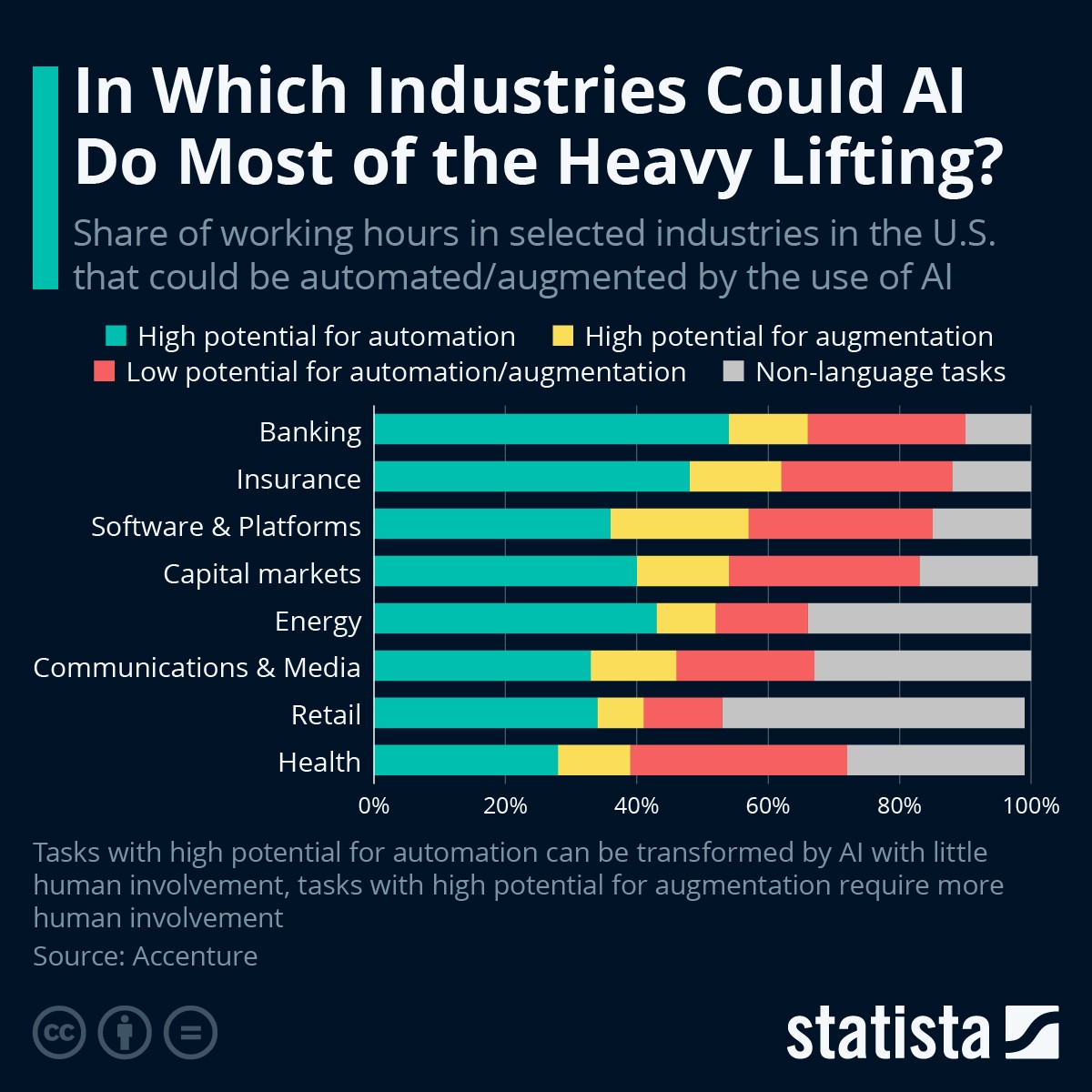
The top industries include:
- Technology and Software Services: The backbone of AI development, offering roles in AI and machine learning development, software engineering, and system architecture.
- Finance and Banking: Utilizes AI for fraud detection, risk management, and customer service automation.
- Healthcare: Implements AI in diagnostics, patient care, and medical data analysis.
- Automotive: Employs AI in autonomous driving technologies, manufacturing automation, and customer experience.
- Retail: Uses AI for inventory management, personalized shopping experiences, and supply chain optimization.
- Manufacturing: Leverages AI for predictive maintenance, production planning, and quality control.
AI Jobs by Job Type:
AI employment opportunities vary widely, catering to different skill sets and interests within the AI field. Common AI job types include:
- AI and Machine Learning Engineers: Focus on developing AI models and systems.
- Data Scientists: Analyze and interpret complex data to aid decision-making.
- Research Scientists: Conduct research to advance the field of AI.
- AI Developers: Create and program AI software and applications.
- Robotics Engineers: Design and develop robots that operate autonomously or semi-autonomously.
- Natural Language Processing Specialists: Work on systems that understand and interpret human language.
Remote vs. Onsite AI Jobs Statistics:
The AI sector, like many others, has seen a shift in the balance between remote and onsite work, especially influenced by the global pandemic. While specific statistics for 2024 are not available in this context, general trends indicate:
- Increased Remote Opportunities: The tech industry, including AI, has embraced remote work, with many companies offering fully remote or hybrid positions.
- Onsite Roles: Certain jobs, especially those requiring hands-on work with hardware (e.g., robotics engineers) or secure data (e.g., in finance and healthcare), may still require onsite presence.
Top Industries for AI Employment
- Technology and Software Services: Leading in AI job creation, focusing on research, development, and application of AI technologies.
- Finance and Banking: Employing AI for fraud detection, risk management, and customer insights.
- Healthcare: Utilizing AI for diagnostics, patient management, and treatment personalization.
- Automotive and Manufacturing: Innovating with AI for autonomous driving, production optimization, and quality control.
- Retail and E-commerce: Leveraging AI for customer experience enhancement, inventory management, and personalized recommendations.
| Industry | AI Applications |
|---|---|
| Technology | Development, Software Engineering |
| Finance and Banking | Fraud Detection, Risk Management |
| Healthcare | Diagnostics, Patient Care |
| Automotive | Autonomous Driving, Manufacturing |
| Retail | Inventory Management, Personalization |
| Manufacturing | Predictive Maintenance, Quality Control |
Top Companies Hiring for AI Roles:
A few notable companies actively hiring for AI roles include:
- OpenAI and DeepMind: Leading in AI research and ethical AI development.
- Amazon and Google: Offering various AI roles across various applications and services.
- IBM and Intel: Pioneering in AI hardware and enterprise AI solutions.
- Startup companies like Grammarly and Dataiku: Innovating in AI-driven communication and data science platforms.
AI Jobs by Job Type
| Job Type | Role Description |
|---|---|
| AI and Machine Learning Engineers | Developing AI models and systems |
| Data Scientists | Analyzing and interpreting complex data |
| Research Scientists | Advancing AI through research |
| AI Developers | Creating AI software and applications |
| Robotics Engineers | Designing autonomous or semi-autonomous robots |
| NLP Specialists | Working on human language understanding systems |
Remote vs. Onsite AI Jobs
| Work Type | Description |
|---|---|
| Remote | Work from anywhere, prevalent in tech roles |
| Onsite | Required physical presence, e.g., robotics |
Talking about the demand for AI professionals is on the rise, with companies across various industries looking to hire skilled AI employees.
Companies such as Amazon, NVIDIA, and Microsoft are heavily investing in AI services and are actively recruiting top AI talent to help scale their AI efforts.
AI Job Replacement Statistics
Here are some statistics on AI job replacement statistics based on the available sources:
- Impact of AI and Automation on Wages: Early AI and automation have already driven down wages by up to 70% since 1980. Educated, white-collar workers are expected to be impacted by automation, with half of businesses having integrated AI into their operations.
- Job Displacement and Replacement Statistics: More than one-third (37%) of business leaders say AI replaced workers in 2023, according to a recent report from ResumeBuilder. Additionally, employees report that 29% of their work tasks are replaceable by AI.
- Industries Exposed to AI Automation: Industries such as office and administrative support, legal, architecture and engineering, and life, physical, and social science are estimated to have a significant share of employment exposed to AI-driven automation, with percentages ranging from 36% to 46%.
If you’re looking for the difference in actual and expected impact of AI on jobs, then here it is:
- Expected Impact:
- In 2022, 19% of American workers were in jobs that are the most exposed to AI, in which the most important activities may be either replaced or significantly impacted by AI.
- Industries such as office and administrative support, legal, architecture and engineering, and life, physical, and social science are estimated to have a significant share of employment exposed to AI-driven automation, with percentages ranging from 36% to 46%.
- Actual Impact:
- According to a report published by Goldman Sachs Global Investment Research, the estimated share of U.S. employment exposed to AI-driven automation is as follows:
- Office and administrative support: 46%
- Legal: 44%
- Architecture and engineering: 37%
- Life, physical, and social science: 36%.
- With projections that AI could potentially replace around 800 million jobs worldwide by 2030, the impact of AI on employment is a significant and evolving reality.
- According to a report published by Goldman Sachs Global Investment Research, the estimated share of U.S. employment exposed to AI-driven automation is as follows:
AI Job Impact by Sector
| Sector | Potential Impact | Percentage of Jobs Affected |
|---|---|---|
| Transportation | Automation | Up to 56% |
| Storage | Automation | Up to 56% |
| Retail | Transformation | Up to 56% |
| Administration | High Automation Risk | Up to 56% |
There’s also a Job Impact Index, created by thereisanaiforthat.com that shows the total number of jobs impacted based on AI tools created.
So say, if there are a lot of AI tools built around one particular sector, then the job impact index will be higher.
Here’s the current Job Impact Index:
| S.No | Job Title | AI Impact |
|---|---|---|
| 1 | Communications Manager | 98% |
| 2 | Data Collector | 95% |
| 3 | Data Entry | 95% |
| 4 | Mail Clerk | 95% |
| 5 | Compliance Officer | 92% |
| 6 | Chief Executive Officer (CEO) | 91% |
| 7 | Therapist | 90% |
| 8 | Chief Strategy Officer | 90% |
| 9 | Admin | 90% |
| 10 | General Clerk | 90% |
| 11 | Mail Handler | 90% |
| 12 | Data Clerk | 90% |
| 13 | Data Entry Clerk | 90% |
| 14 | Data Entry Operator | 90% |
| 15 | Data Entry Specialist | 90% |
| 16 | Medical Transcriptionist | 90% |
| 17 | Street Sweeper | 90% |
| 18 | Supply Clerk | 90% |
| 19 | Warehouse Worker | 90% |
| 20 | Web Search Evaluator | 90% |
And That’s a Wrap
And that’s everything on AI job statistics we’ve gathered.
The big takeaway? AI is changing jobs faster than we’ve ever seen before. It’s creating new opportunities while also making some jobs less needed. This shift is huge, and it’s happening right now.
So, what do you think about all this?
Is the rise of AI jobs a good thing for us? Are there other stats or areas you’re curious about? Got any questions on this topic?
Feel free to share your thoughts or ask away. Let’s get the conversation going!


